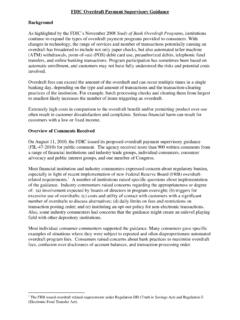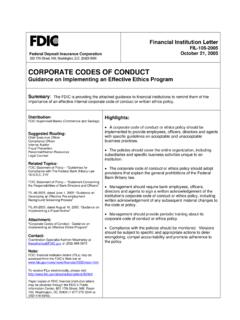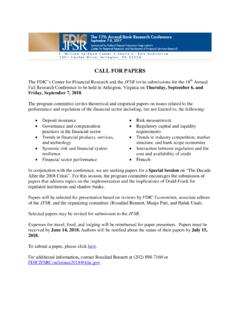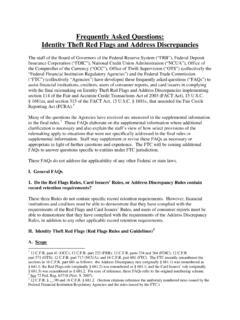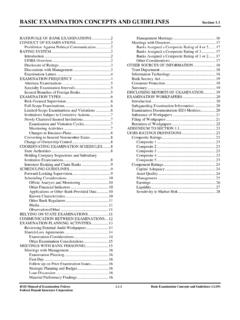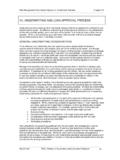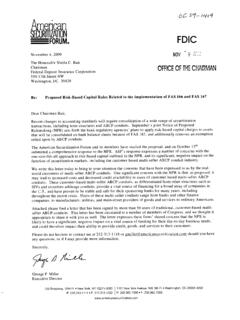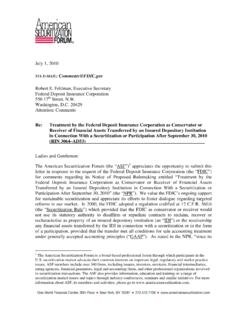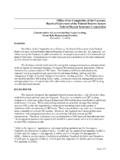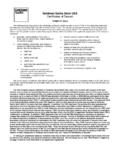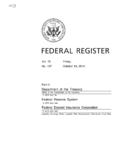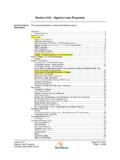Transcription of OTHER ASSETS AND LIABILITIES - Federal Deposit …
1 OTHER ASSETS AND LIABILITIES section INTRODUCTION ..2 OTHER ASSETS ..2 Accrued Income ..2 Tax ASSETS ..2 Interest-Only Strips ..3 Equities without Readily Determinable Fair Values ..3 Bank-Owned Life insurance Miscellaneous ASSETS ..4 Prepaid Expenses ..4 Repossessed Personal Property ..4 Suspense Cash Items Not In Process Of OTHER Accrued Interest Receivables ..5 Indemnification INTANGIBLE ASSETS ..5 Goodwill and OTHER Intangible ASSETS ..5 Accounting for Goodwill ..6 Servicing ASSETS ..6 Accounting ..6 Valuation ..7 Regulatory Capital ..8 Servicing Risk ..8 Examination OTHER LIABILITIES ..8 OTHER Borrowed Money ..9 Accrued Expenses ..9 Servicing Deferred Tax LIABILITIES ..9 Allowance for Off-Balance Sheet All OTHER Miscellaneous LIABILITIES ..9 RMS Manual of Examination Policies OTHER ASSETS and OTHER LIABILITIES (3/12) Federal Deposit insurance corporation OTHER ASSETS AND LIABILITIES section INTRODUCTION ASSETS and LIABILITIES that are not reported in major balance sheet categories are generally reported in OTHER asset or OTHER liability categories.
2 Although these items are listed in " OTHER " categories, it does not mean the accounts are of less significance than items detailed in major categories. Intangible ASSETS lack physical substance and are also reported separately on the balance sheet. The following pages include descriptions of common OTHER ASSETS , intangible ASSETS , and OTHER LIABILITIES . Additional guidance and information is included in the Call Report Instructions and the Examination Documentation (ED) Module - OTHER ASSETS and LIABILITIES . OTHER ASSETS Accrued Income All banks, regardless of size, shall prepare the Call Report on an accrual basis. Accrued income represents the amount of interest earned or accrued on earning ASSETS and applicable to current or prior periods that has not yet been collected.
3 Examples include accrued interest receivable on loans and investments. When income is accrued but not yet collected, a bank debits a receivable account and credits an applicable income account. When funds are collected, cash or an equivalent is debited, and the receivable account is credited. The degree to which accrual accounts and practices are reviewed during an examination should be governed by the examination scope. When scoping examination procedures, examiners should consider the adequacy of a bank s internal control structure and the extent to which accrual accounting procedures are analyzed during audits. When reviewing accrual accounts and practices, examiners should assess the general accuracy of the accrual accounting system and determine if accruals relate to items in default or to items where collection is doubtful.
4 If accrued income accounts are materially overstated, examiners should consider the impact to overall profitability levels, classify overstated amounts as Loss, and recommend management amend Call Reports. Tax ASSETS Banks must estimate the amount of the current income tax liability (or receivable) to be reported on its tax returns. Estimating this liability (or receivable) may involve consultation with the bank's tax advisers, a review of the previous year's tax returns, the identification of significant expected differences between items of income and expense reflected on the Call Report and on the tax returns, and the identification of expected tax credits. Deferred tax ASSETS and LIABILITIES represent the amount by which taxes receivable (or payable) are expected to increase or decrease in the future as a result of temporary differences and net operating losses or tax credit carryforwards that exist at the reporting date.
5 When determining the current and deferred income tax ASSETS and LIABILITIES to be reported in any period, a bank s income tax calculation will contain an inherent degree of uncertainty surrounding the realizability of the tax positions included in the calculation. A net deferred tax asset is reported if a debit balance results after offsetting deferred tax ASSETS (net of valuation allowance) and deferred tax LIABILITIES measured at the report date for a particular tax jurisdiction. If the result for a particular tax jurisdiction is a net credit balance, then a net deferred tax liability is reported. A bank may report a net deferred tax debit, or asset , for one tax jurisdiction, such as for Federal income tax purposes, and also report at the same time a net deferred tax credit, or liability, for another tax jurisdiction, such as for state or local income tax purposes.
6 Temporary differences arise when an institution recognizes income or expense items on the books during one period, but records them for tax purposes in another period. For example a deductible temporary difference is created when a provision for loan and lease losses is expensed in one period for financial reporting purposes, but deferred for tax purposes until the loans are charged off in a subsequent period. A bank sustains an operating loss when deductions exceed income for Federal income tax purposes. An operating loss in a year following periods when the bank had taxable income may be carried back to recover income taxes previously paid. Banks may carry back operating losses for two years.
7 Generally, an operating loss that occurs when loss carrybacks are not available ( , when losses occur in a year following periods of losses) becomes an operating loss carryforward. Banks may carry operating losses forward 20 years. Tax credit carryforwards are tax credits that cannot be used for tax purposes in the current year, but which can be carried forward to reduce taxes payable in a future period. Deferred tax ASSETS are recognized for operating loss and tax credit carryforwards just as they are for deductable temporary differences. However, a bank can only recognize the benefit of a net operating loss, or a tax credit OTHER ASSETS and OTHER LIABILITIES (3/12) RMS Manual of Examination Policies Federal Deposit insurance corporation OTHER ASSETS AND LIABILITIES section carryforward, to the extent the bank determines that a valuation allowance is not necessary.
8 A valuation allowance must be recorded, if needed, to reduce the amount of deferred tax ASSETS to an amount that is more likely than not to be realized. Examiners should obtain management s analysis and support for any deferred tax asset and valuation allowance reported for financial reporting purposes. Examiners should refer to the Call Report Glossary for guidance on income taxes and may contact the regional accounting specialist for further guidance in cases involving significant amounts of net deferred tax ASSETS . Part 325 of the FDIC Rules and Regulations, Capital Maintenance (Part 325), establishes limitations on the amount of deferred tax ASSETS that can be included in Tier 1 capital.
9 The maximum allowable amount is limited to the lesser of: the amount of deferred tax ASSETS dependent upon future taxable income expected to be realized within one year of the calendar quarter-end date, based on projected future taxable income for that year; or ten percent of the amount of Tier 1 capital that exists before certain deductions. Refer to Part 325 for more details. Interest-Only Strips Accounting standards for interest-only strips receivable are set forth in ASC 860, Transfers and Servicing (formerly FAS 140, Accounting for Transfers and Servicing of Financial ASSETS and Extinguishments of LIABILITIES , as amended by FAS 156, Accounting for Servicing of Financial ASSETS , FAS 166, Accounting for Transfers of Financial ASSETS , and certain OTHER standards).
10 ASC 860 defines interest-only strips receivable as the contractual right to receive some or all of the interest due on a bond, mortgage loan, collateralized mortgage obligation, or OTHER interest-bearing financial asset . Financial ASSETS such as interest-only strips receivable, that can contractually be prepaid or otherwise settled in such a way that the holder of the financial asset would not recover substantially all of its recorded investment do not qualify to be accounted for at amortized cost. Interest-only strips subsequently measured at fair value like available-for-sale securities are reported as OTHER ASSETS . Alternatively, interest-only strips may be reported as trading securities.
